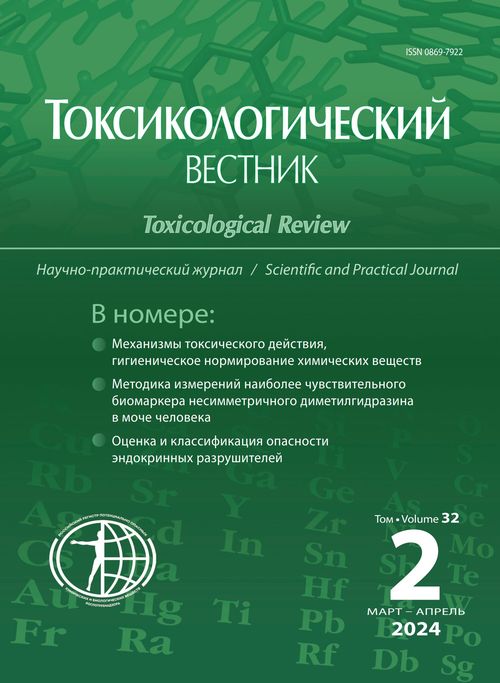Development of a method for measuring the most sensitive biomarker of unsymmetrical dimethylhydrazine in human urine
- Authors: Ukolov A.I.1,2, Karmanov E.Y.1, Erunova N.V.1, Radilov A.S.1
-
Affiliations:
- FSUE “Research Institute of Hygiene, Occupational Pathology and Human Ecology” FMBA of Russia
- FSBF SCCT of S.N. Golikov Federal Medical-Biological Agency
- Issue: No 2 (2024)
- Pages: 108-114
- Section: Research methods
- Published: 27.04.2024
- URL: https://rjsocmed.com/0869-7922/article/view/641545
- DOI: https://doi.org/10.47470/0869-7922-2024-32-2-108-114
- ID: 641545
Cite item
Full Text
Abstract
The aim of the study is to develop a new highly sensitive method for biological monitoring of UDMH using the most sensitive exposure biomarker – pyridoxal dimethylhydrazone in human urine using high-performance liquid chromatography with tandem mass spectrometric detection (HPLC-MS/MS).
Material and methods. measurement of mass concentrations of pyridoxal dimethylhydrazone in urine was performed by HPLC-MS/MS in reverse-phase HPLC mode with preliminary concentration by solid-phase extraction. To ensure the uniformity of measurements, a standard sample of pyridoxal dimethylhydrazone was synthesized domestically according to the previously described scheme [9].
Results. a method for measuring mass concentrations of pyridoxal dimethylhydrazone in urine in the range from 10 ng/ml to 1 μg/ml was developed, metrologically certified and entered into the Federal Register by HPLC-MS with solid-phase extraction.
Limitations of the study. ensuring the lower limit of quantification is achieved only through the use of a tandem mass selective detector. When using single quadrupole detectors, the limit increases by an order of magnitude.
Conclusion. it is advisable to carry out biological monitoring of the industrial effects of UDMH on the body of people in contact with it based on the quantitative determination of pyridoxal dimethylhydrazone in urine using the HPLC-MS method. The developed method makes it possible to measure the mass concentrations of pyridoxal dimethylhydrazone in urine in the range from 10 ng/ml to 1 μg/ml, which, according to estimates, will reveal the intake of 210 μg of UDMH per person weighing 70 kg per shift, corresponding to an 8-hour exposure to concentration 21 µg/m3 or 1/5 TWA (0.1 mg/m3).
About the authors
Anton I. Ukolov
FSUE “Research Institute of Hygiene, Occupational Pathology and Human Ecology” FMBA of Russia; FSBF SCCT of S.N. Golikov Federal Medical-Biological Agency
Author for correspondence.
Email: AntonUkolov@gmail.com
ORCID iD: 0000-0002-2911-1260
Канд. хим. наук, заведующий отделом токсикологии ФГУП «НИИ ГПЭЧ» ФМБА, 188663, Ленинградская область, Российская Федерация
e-mail: AntonUkolov@gmail.com
Russian FederationEvgeniy Yu. Karmanov
FSUE “Research Institute of Hygiene, Occupational Pathology and Human Ecology” FMBA of Russia
Email: karmanov@gpech.ru
Научный сотрудник ФГУП «НИИ ГПЭЧ» ФМБА России, 188663, Ленинградская область, Российская Федерация
e-mail: karmanov@gpech.ru
Russian FederationNataliya V. Erunova
FSUE “Research Institute of Hygiene, Occupational Pathology and Human Ecology” FMBA of Russia
Email: erunova@gpech.ru
Канд. мед. наук, ведущий научный сотрудник ФГУП «НИИ ГПЭЧ» ФМБА,188663, Ленинградская область, Российская Федерация
e-mail: erunova@gpech.ru
Russian FederationAndrey S. Radilov
FSUE “Research Institute of Hygiene, Occupational Pathology and Human Ecology” FMBA of Russia
Email: radilov@gpech.ru
ORCID iD: 0000-0003-0776-7434
Russian Federation
References
- Бугаев П.А., Антушевич А.Е., Рейнюк В.Л., Башарин В.А., Зацепин В.В. Гидразин и его производные: токсикологическая характеристика. Современные проблемы науки и образования. 2017; 4: 31.
- Мешков Н.А. Методические основы оценки влияния последствий ракетно-космической деятельности на здоровье населения, проживающего вблизи районов падения отделяющихся частей ракет-носителей. Российский биомедицинский журнал. 2009; (10): 57–80.
- Панин Л.Е., Перова А.Ю. Медико-социальные и экологические проблемы использования ракет на жидком топливе (гептил). Сибирское отделение Российской академии медицинских наук. 2006; 26(1): 124–31.
- Робертус Ю.В., Пузанов А.В., Любимов Р.В., Архипов И.А., Горбачев И.В. Анализ распределения фрагментов отделяющихся частей ракетоносителей «Протон» на территории Республики Алтай. Мир науки, культуры, образования. 2013; (2): 314–7.
- Koseniauskas R., Burak E.S. Reduced Blood Clearance and Increased Urinary Excretion of Nitrosodimethylamine in Patas Monkeys Exposed to Ethanol or Isopropyl Alcohol. American Association for Cancer Research. 1992; 52: 1463–8.
- Tomera J.F., Skipper P.L., Wishnoc J.S. Inhibition of N-nitrosodimethylamine metabolism by ethanol and other inhibitors in the isolated perfused rat liver. Cacinogenesis (Lond.). 1984; 5: 113–6.
- Garland W.A., Kuenzig W., Rubio F., Kornychuk H., Norkus E.P., Conney A.H. Urinary Excretion of Nitrosodimethylamine and Nitrosoproline in Humans: Interindividual and Intraindividual Differences and the Effect of Administered Ascorbic Acid and a-Tocopherol. Cancer research. 1986; 46(10): 5392–400.
- Dunn S.R., Pensabene J.W., Simenhoff M.L. Analysis of human blood for volatile N-nitrosamines by gas chromatography-chemiluminescence detection. Journal of Chromatography. 1986; 377: 35–47.
- Уколов А.И., Лаптев Д.С., Карманов Е.Ю., Каракашев Г.В., Криворотов Д.В., Богаченков А.С., Нечайкина О.В., Бобков Д.В., Петунов С.Г. Новые биомаркеры несимметричного диметилгидразина. Токсикологический вестник. 2022; 30(3): 182–190. https://doi.org/10.47470/0869-7922-2022-30-3-182-190.
- Уколов А.И., Радилов А.С. О развитии идей биологического контроля производственного воздействия вредных химических веществ (дискуссия). Мед. труда и пром. экол. 2022; 62(11): 740–746. https://doi.org/10.31089/1026-9428-2022-62-11-740-746
- Carlsen L., Kenesova O.A., Batyrbekova S.E. A preliminary assessment of the potential environmental and human health impact of unsymmetrical dimethylhydrazine as a result of space activities. Chemosphere. 2007; 67(6): 1108–16. https://doi.org/10.1016/j.chemosphere.2006.11.046
- Манухов И.В., Вагапова Э.Р., Кессених А.Г. и др. Экспериментальные исследования влияния низких концентраций гептила и продуктов его гидролиза на воду и биологические объекты. Под редакцией Л.С. Ягужинского. Москва: Московский физико-технический институт (государственный университет); 2015. https://elibrary.ru/zammrx
Supplementary files









